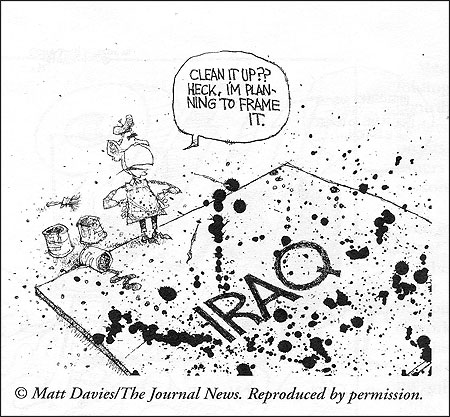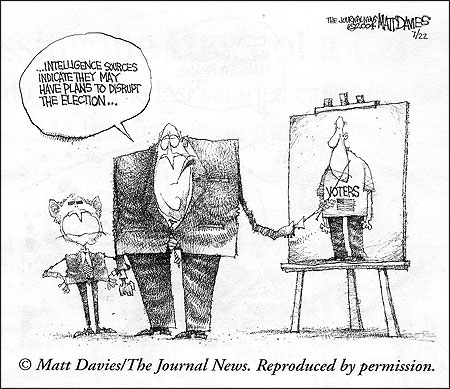
Unexpectedly, I’ve found myself—as current president of the Association of American Editorial Cartoonists (AAEC)—becoming a public advocate for our profession. In past years, being AAEC president has meant 10 months spent trying to get a terrific speaker or two to come to our annual convention at no charge. But now, as I put our issues before the public in media interviews, I’m invariably asked about the demise of the editorial cartoonist. This new interest in our fate is a bit unusual, not because we haven’t lamented the lack of jobs for as long as I remember, but because people other than cartoonists now seem to be noticing our thinning ranks and wondering why it’s happening and what it means.
From our vantage point, the issue isn’t that people—or even editors— don’t like editorial cartoons; it’s just that they don’t want to pay for them when they don’t have to. Brilliant and pithy cartoons seem so simple and easy to produce that people approach me all the time with their ideas for a cartoon or two: “I can’t draw, but I have tons of ideas for cartoons,” they tell me. Why pay good money for something that everybody seems to think they can do? In some ways, this dynamic is not unlike humankind’s quest for flight, when for centuries people watched birds drifting effortlessly, strapped on some wings, gathered townsfolk, found a high place, and jumped. Every day, editorial cartoonists troll the news in search of social and political ironies, then create images that encapsulate those metaphorical 1,000 words and pour them painstakingly into a single picture. For most professional cartoonists, drawing is the easy part. Like flying, the whole process is a lot harder to do than it looks.
In fairness, editorial cartoonists can be quite disruptive to an editorial page editor’s work. An editor with the intestinal fortitude to oversee a staff cartoonist will inevitably have to deal with angry readers, many of whom can be notoriously time-consuming. This is especially problematic in today’s marketplace where newspapers are sometimes referred to as “the product” and readers are affectionately called “customers.” Into this corporate environment arrives the editorial cartoonist. Imagine if a Ronald McDonald character wandered around McDonald’s restaurants harassing customers by pointing out their faults and berating them for the SUV in which they arrived, and you have a sense of how a lot of cartoonists are perceived in many media boardrooms. They are regarded as anathema to the culture that exists to provide a “service.”
No matter how hard marketing specialists try, newspapers will never be only products. When newspapers report the news and provide a decent editorial page, they will—by their mission and definition—engender controversy and, consequently, be purchased and read by people in their community.

Looking Back, Looking Forward
Most American editorial pages still have the problem of what to put in the pesky space—a decent-sized box at the top of the page—traditionally given the staff editorial cartoonist. For the time being, many have hit on the idea of buying syndicated creators—generally ones who are also earning a salary at another newspa-per—for a very small sum. If they are adventurous with their budget, editors can buy images done by several cartoonists, then perform a sort of editorial triage and publish only the least offensive material. Doing this allows them to avoid the irritation of having to depend on what a staff cartoonist might have produced that day. This is particularly useful when it comes to some of the stickier local issues that can really get readers in a huff. Staff cartoonists might weigh in on a local story and cause reams of letters to be written and phones to ring incessantly—in short, to get readers engaged with the newspaper.
RELATED ARTICLE
"Cartoonists Reach Out to Educators"
- Matt DaviesEven though there’s an inherent shortsightedness to this buy-a-cartoon model, these days when a cartoonist leaves his/her newspaper—generally due to editorial disagreement and/or death—it’s commonplace for the bereaved newspaper to use syndicated material “until a replacement is found.” Over time, this temporary strategy can get to feel very comfortable, and it is cheap. I can’t help wondering what these newspapers are going to do when the last salaried cartoonist drops dead and suddenly there’s nothing to publish in that box on all these editorial pages. I can imagine hearing words like these being spoken: “Will someone please hire a cartoonist so we can start buying her cartoons through the syndicate?”
RELATED ARTICLE
"An Historic Look at Political Cartoons"
- Harry KatzThe value of having a good and consistent cartoonist’s voice in the paper was evident to those who edited and published earlier American newspapers. There’s a proud tradition of biting editorial cartooning, from Thomas Nast (who brought us the elephant, the donkey and my personal favorite, Uncle Sam) in the 19th century, through Herblock, Bill Mauldin, Pat Oliphant, and Jeff MacNelly, who respectively defined and encapsulated the political landscape of the 20th century.

Now we sit at the beginning of the 21st century, already a time of volatile global political change that begs for the type of commentary only a cartoonist can wield. Yet the soil that grows and nurtures cartoonists whose work can define our time is less fertile than ever.
Ten years ago there were 150 or so salaried editorial cartoonists working at daily newspapers. There are now about 85 of us left, and the business and media environment in which newspapers exist has changed enormously. Newspapers are fighting for media share with broadcast TV, cable, radio and the Web, and are increasingly excluding us from their marketing plans. The Chicago Tribune, one of the nation’s biggest and best-known newspapers, still hasn’t filled its coveted cartooning position since the untimely death in 2000 of staffer MacNelly, who was one of cartooning’s biggest and best. The St. Louis Post-Dispatch hasn’t filled a long open vacancy. The San Jose Mercury News and the St. Paul Pioneer Press have both dispensed with their high-profile cartooning positions. The New York Times hasn’t had its own cartoonist for decades, and chances are good that your local daily paper probably doesn’t have its own cartoonist either.
That’s the barrel that this president of the Association of American Editorial Cartoonists is reluctantly staring down. When contemplating which media commentator working today is closest—in terms of influence and reach—to our 19th century cartooning hero Nast, the name that surfaces is Jon Stewart, the crown prince of political satire, whose words are broadcast, not drawn and published. Which leaves me to ponder: Can Jon Stewart draw?
Matt Davies is staff cartoonist for The Journal News in White Plains, New York, and also serves as the president of the Association of American Editorial Cartoonists. In 2004, he won the Pulitzer Prize for editorial cartooning.



